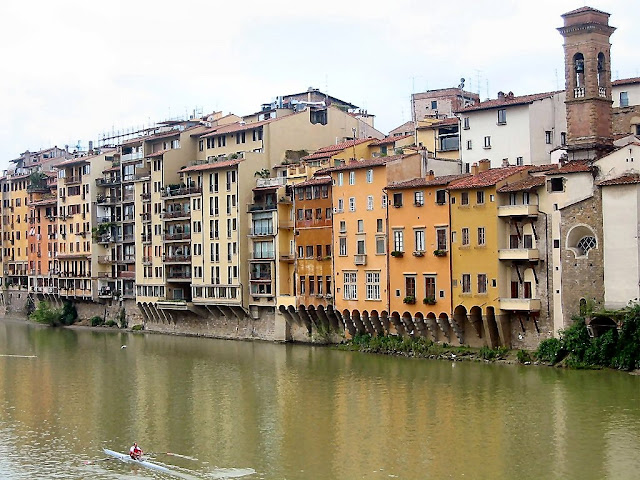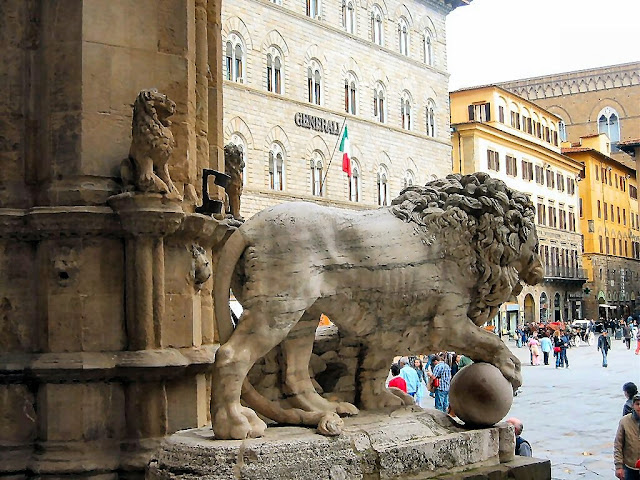May 2004 - Florence Italy
Continuing with our first Italian viaggio. we took the train from Rome to Florence.
The train ride is about 1.5 hours.
We had booked our hotel online.
First things first!
This post will be picture heavy and word light.
Along the River Arno.
Built very close to the Roman crossing, the Ponte Vecchio, or Old Bridge, was the only bridge across the Arno in Florence until 1218. The current bridge was rebuilt after a flood in 1345. During World War II it was the only bridge across the Arno that the fleeing Germans did not destroy. Instead they blocked access by demolishing the medieval buildings on each side. On November 4, 1966, the bridge miraculously withstood the tremendous weight of water and silt when the Arno once again burst its banks.
Incredible street art!
The Piazza della Signoria has been the center of political life in Florence since the 14th century with the prominent Palazzo Vecchio overlooking the square. It was the scene of great triumphs, such as the return of the Medici in 1530 as well as the Bonfire of the Vanities instigated by Savonarola, who was then himself burned at the stake here in 1498 after he was denounced by the Inquisition as a heretic.
The Nettuno (1575) by Ammannati celebrates the Medici's maritime ambitions and Giambologna's equestrian statue of Duke Cosimo I (1595) is an elegant portrait of the man who brought all of Tuscany under Medici military rule.
The David (the original is in the Galleria dell'Accademia) by Michelangelo was placed outside the Palazzo Vecchio as a symbol of the Republic's defiance of the tyrannical Medici.
The right hand is disproportionately large. Some believe this was Michelangelo’s nod to the nickname of David, manu fortis– strong of hand.
Florence's cathedral stands tall over the city with its magnificent Renaissance dome designed by Filippo Brunelleschi, with the baptistery right across. The cathedral named in honor of Santa Maria del Fiore is a vast Gothic structure built on the site of the 7th century church of Santa Reparata, the remains of which can be seen in the crypt.
The Galleria degli Uffizi, also known as the Uffizi Gallery, Italy's top art museum.
Perseo by Cellini brandishing the head of Medusa which was on my bucket list for our upcoming visit, but apparently we've seen it! However, hopefully we will get better shots.
The Medici lions are a pair of marble sculptures of lions, one of which is Roman, dating to the 2nd century AD, and the other a 16th-century pendant; both were by 1598 placed at the Villa Medici, Rome. Since 1789 they have been displayed at the Loggia dei Lanzi. The sculptures depict standing male lions with a sphere or ball under one paw, looking to the side. The Medici lions have been copied and publicly installed in over 30 other locations.
Intricate exterior designs decorate this Florentine building.
The Marzocco is the heraldic lion that is a symbol of Florence, and was apparently the first piece of public secular sculpture commissioned by the Republic of Florence, in the late 14th century. It stood at the heart of the city in the Piazza della Signoria at the end of the platform attached to the Palazzo Vecchio called the ringhiera, from which speakers traditionally harangued the crowd. This is now lost, having weathered with time to an unrecognizable mass of stone.
Piazza della Signoria - Statua del Marzocco by Bardazzi Luca
The Palazzo Pitti, in English sometimes called the , , is a vast, mainly Renaissance, palace.
Purchased in 1550, the Palace was chosen by Cosimo I de’ Medici and his wife Eleanor of Toledo as the new Grand Ducal residence, and it soon became the new symbol of the Medici’s power over Tuscany. It was also the royal palace of other two dynasties: the House of Lorraine-Habsburg (which succeeded the Medici from 1737) and the Kings of Italy of the House of Savoy, who inhabited it from 1865. Nonetheless the palace still bears the name of its first owner, the Florentine banker Luca Pitti that in the mid-1400s started its construction – maybe after a design by Brunelleschi – at the foot of the Boboli hill beyond the Arno river.
Commissioned during the height of the Medici family’s reign in 16th-century Florence, Buontalenti Grotto (Grotta di Buontalenti) is the largest grotto in the city. Sculptures of mythical creatures and man-made stalagmites covering its facade and interior make the grotto one of the most popular landmarks in the Boboli Gardens.
Piazza Santa Maria Novella is one of main squares in Florence and one of the most beautiful, making it one of the top attractions in the city. The historical center is divided into 4 quarters and life in the quarter of Santa Maria Novella revolves around its square.
The Palazzo Pitti, in English sometimes called the , , is a vast, mainly Renaissance, palace.
Purchased in 1550, the Palace was chosen by Cosimo I de’ Medici and his wife Eleanor of Toledo as the new Grand Ducal residence, and it soon became the new symbol of the Medici’s power over Tuscany. It was also the royal palace of other two dynasties: the House of Lorraine-Habsburg (which succeeded the Medici from 1737) and the Kings of Italy of the House of Savoy, who inhabited it from 1865. Nonetheless the palace still bears the name of its first owner, the Florentine banker Luca Pitti that in the mid-1400s started its construction – maybe after a design by Brunelleschi – at the foot of the Boboli hill beyond the Arno river.
Commissioned during the height of the Medici family’s reign in 16th-century Florence, Buontalenti Grotto (Grotta di Buontalenti) is the largest grotto in the city. Sculptures of mythical creatures and man-made stalagmites covering its facade and interior make the grotto one of the most popular landmarks in the Boboli Gardens.
The enchanting beauty of the Dominican Basilica of Santa Maria Novella's Renaissance facade is usually what impresses the most at first sight,








































































...Jackie, what a gorgeous city filled with amazing treasures. It's hard to drink them all in at once. Thanks for sharing, enjoy this spring weather.
ReplyDeleteMarvelous post! So much art and architecture!
ReplyDeleteAn exquisitely beautiful city!
ReplyDelete